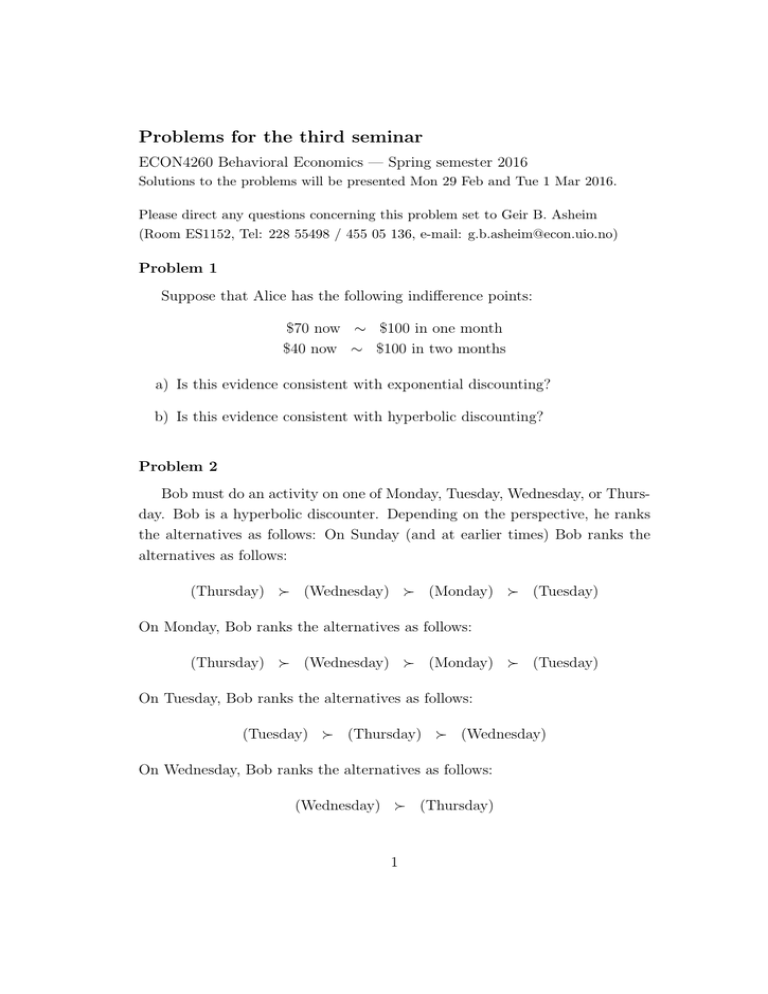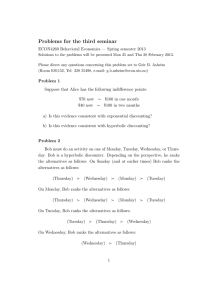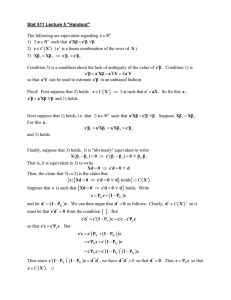Problems for the third seminar
advertisement

Problems for the third seminar
ECON4260 Behavioral Economics — Spring semester 2016
Solutions to the problems will be presented Mon 29 Feb and Tue 1 Mar 2016.
Please direct any questions concerning this problem set to Geir B. Asheim
(Room ES1152, Tel: 228 55498 / 455 05 136, e-mail: g.b.asheim@econ.uio.no)
Problem 1
Suppose that Alice has the following indifference points:
$70 now ∼ $100 in one month
$40 now ∼ $100 in two months
a) Is this evidence consistent with exponential discounting?
b) Is this evidence consistent with hyperbolic discounting?
Problem 2
Bob must do an activity on one of Monday, Tuesday, Wednesday, or Thursday. Bob is a hyperbolic discounter. Depending on the perspective, he ranks
the alternatives as follows: On Sunday (and at earlier times) Bob ranks the
alternatives as follows:
(Thursday) (Wednesday) (Monday) (Tuesday)
On Monday, Bob ranks the alternatives as follows:
(Thursday) (Wednesday) (Monday) (Tuesday)
On Tuesday, Bob ranks the alternatives as follows:
(Tuesday) (Thursday) (Wednesday)
On Wednesday, Bob ranks the alternatives as follows:
(Wednesday) (Thursday)
1
a) Is this activity a burdensome activity or a pleasurable activity? Briefly
explain.
b) If Bob is naive, when will he do the activity? Briefly explain.
c) If Bob is sophisticated, when will he do the activity? Briefly explain.
d) In this instance, which generates a larger welfare loss, sophistication or
naivet? Briefly explain.
Problem 3 (Adapted from a problem due to Ted O’Donoghue.)
Suppose that a person will live for 3 periods. In periods 1 and 2, she
chooses whether to engage in some indulgent activity, and then in period 3 she
incurs costs from this indulgence. In addition, the person’s desire to indulge
in period 2 depends on whether she indulges in period 1. More precisely:
In period 1, the person chooses a1 ∈ {0, 1}, and her period-1 instantaneous
utility u1 is:
If a1 = 0 u1 = 0
If a1 = 1 u1 = 10
In period 2, the person chooses a2 ∈ {0, 1}, and her period-2 instantaneous
utility u2 is:
Given a1 = 0 : Given a1 = 1 :
If a2 = 0
u2 = 0
u2 = 0
If a2 = 1
u2 = 10
u2 = 12
In period 3, her period-3 instantaneous utility u3 is:
Given a1 = 0 : Given a1 = 1 :
Given a2 = 0 :
u3 = 0
u3 = −21
Given a2 = 1 :
u3 = −14
u3 = −35
Suppose that the person has (β, δ)-intertemporal preferences, and assume
for simplicity that δ = 1.
(a) Suppose β = 1. Solve for a1 and a2 .
2
(b) Suppose β = 21 , and assume that the person is completely sophisticated.
Solve for a1 and a2 .
(c) Suppose β = 12 , and assume that the person is completely naı̈ve. Solve
for a1 and a2 .
(d) Given β = 12 , compare the welfare of sophisticates to naifs in terms of
period-1 utility. Suppose now that there is a prior period 0 at which no
decision made, and compare the welfare of sophisticates to naifs in terms
of period-0 utility. Does sophistication make a person better off or worse
off?
[(e) (A harder question which is voluntary.) Consider the model of partial
naivete from O’Donoghue and Rabin (QJE 2001). Given β = 21 , solve
for a1 and a2 as a function of β̂.]
Problem 4 (Adapted from a problem due to Ted O’Donoghue.)
This problem explores the relationship between hyperbolic discounting and
health-club usage.
Suppose there are 30 days in a month, and that on each of these days you
consider going to the health club.
Each visit to the health club generates a future benefit of 30.
Each visit to the health also carries an immediate cost (because exercise
requires effort). However, because your motivation varies from day to day, this
immediate cost will vary from day to day. Specifically, assume that for 10 days
each month you will have a cost of 12, for 10 days each month you will have a
cost of 18, and for the remaining 10 days each month you will have a cost of
24.
The health club offers two contracts:
(1) No monthly fee, but you pay $10 per visit.
(2) Monthly fee of $X, but then you pay nothing per visit.
You must choose your contract in advance (prior to the first day of the month).
Finally, suppose you treat any money spent as a future cost (linear in the
amount of money spent). For instance, under contract (1), if you visit the club
3
on a low-cost day, then you incur an immediate cost of 12 (effort), you incur
a future cost of 10 (price paid), and you receive a future benefit of 30 (health
benefits).
(a) If you are a standard exponential discounter with δ = 1, for what values
of X will you choose contract (2)? If you choose contract (2), what
will be your average price per visit as a function of X? How does this
compare to $10?
(b) If you are a naı̈ve hyperbolic discounter with β = 12 and δ = 1, for what
values of X will you choose contract (2)? If you choose contract (2),
what will be your average price per visit as a function of X? How does
this compare to $10?
(c) If you are a sophisticated hyperbolic discounter with β = 12 and δ = 1,
for what values of X will you choose contract (2)? If you choose contract
(2), what will be your average price per visit as a function of X? How
does this compare to $10?
4



